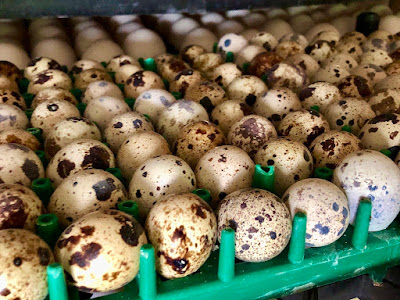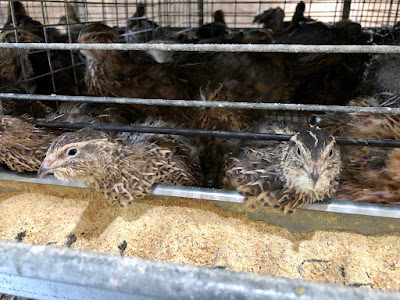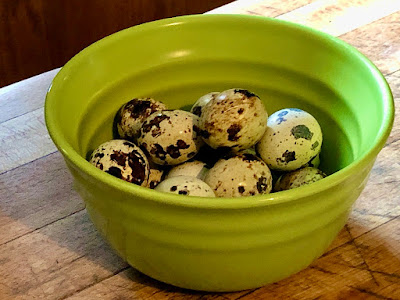During the pandemic, there have been some success stories, of businesses and restaurants which pivoted to new endeavors, allowing them to survive and even thrive. In southern Vermont, I was captivated by the tale of
, which, pre-Covid, primarily sold boneless quail breasts to the restaurant industry. When the restaurants closed during the pandemic, Cavendish lost their main market. How would they survive?
Last month, I traveled to southern Vermont, visiting a few different farms with a couple friends, including Cavendish as I desired to learn more about their quail farm and pivot to the production of Balut. It was a fascinating tour, and we spent about three hours talking with
Rick Thompson, one of the owners, touring the farm, seeing the quail, chicken, and ducks, and finally, getting to sample some Balut.
Cavendish Game Birds was established in 1988 by
Bill Thompson, a chef, who initially started raising pheasants, selling them to local restaurants. At that time, his brother, Rick, was working in food service, for a subsidiary of Heinz. Rick was convinced to join his brother's endeavor, and in 1998, they purchased a 75-acre farm in
Springfield, Vermont. They started selling other game birds as well, from quail to ducks, as well as their eggs.
Over the years, they eventually chose to specialize in raising quail and their eggs, although they still raise chickens and ducks. They purchase other game birds, like pheasant, which they process at their on-site facilities and then sell. They are planning to phase out their chickens though, and then increase duck production.
When Rick spoke to chefs, their local customers, many asked him for larger quails, so the brothers carefully sourced quail eggs which ultimately produced a quail that was 25-30% larger than usual. The eggs they produce are also “jumbo,” larger than the usual quail eggs. In addition, they allow the quail to grow for a longer period, so the birds develop more of a fat layer, which helps the meat remain more moist and tender during cooking. These are high quality quail, and plenty were sold to Boston restaurants over the years.
They are probably the biggest quail producer in Vermont, however they are still relatively small compared to some of the largest commercial quail farms in the country. For example, the two largest farms might be
Manchester Farms in
South Carolina and the
Georgia Quail Farm, also known as
Plantation Farms. Some of these larger farms though produce mainly lower quality quail, intended for inexpensive markets catering to Asians. Cavendish has chosen to produce only top quality quail, to protect their reputation for selling only the best.
Prior to the pandemic, Cavendish faced another serious problem which they were able to overcome. Back in March 2013, there was a fire that destroyed their main building. They had to shut down their business for about 8 months, while they constructed a new building, pictured above. This building is where the breeders are kept, as well as those quail raised for their meat. It's the center of their business, with thousands of bird kept within it.
Pre-Covid, about 90-95% of their business was with restaurants, and as Vermont is very seasonal, Rick also spent a lot of time developing markets in other states so that they could operate year round. About 85-90% of their quail meat was, and still is, boneless, as that is what the restaurants most wanted. Restaurants knew that most of their customers wouldn't want to extract small bones from their quail dinners.
Obviously, once the pandemic struck, restaurants temporarily closed, some for over a year and others permanently shut down. That devastated Cavendish as nearly all of their business was with restaurants. They began to pivot to retail, which took time to grow and certainly didn't provide the regularity of the former restaurant business. They sold quail and their eggs at local farmers markers and online, through
Facebook Marketplace.
These were difficult times and the survival of their business was in question. Fortunately, they were approached by someone who desired a new product that they were uniquely able to provide.
In one of their Facebook Marketplace ads, they offered a variety package of duck and quail eggs for $25. One of the responses to their ad became a turning point. Rick was contacted by
Thang Nyguyen, of
Williston, Vermont, who owned a nail salon, and initially wanted quail eggs for his family and friends. In fact, he bought $300 of eggs in his first order! Quite a large order and then Thang made a few more orders.
Obviously pleased with his purchases, Thang then approached Rick with a special request. Could he provide quail Balut?
As I
mentioned yesterday, Balut is basically an unhatched egg, which contains an embryo, and is most often a duck egg. The egg is hard boiled and then consumed out of the shell. In the
Philippines, it acquired its name,
Balut, and primary fame, although it's also found in a number of other Asian nations, from
Cambodia to
Vietnam. Quail Balut is much less common, and seems more of a Vietnamese delicacy.
At first, Rick was leery of the idea, although he knew little about Balut, and declined Thang's request. It was an unusual request and Rick certainly never considered something like this. However, over time, Rick reconsidered the idea, especially as the business needed more revenue streams. So, he contacted Thang and stated he was willing to produce some Balut, an experiment for all involved.
Rick needed to quickly learn more about Balut, and when he made his first delivery, Thang was very pleased with it, desirous of even more. Thang was essentially a wholesaler, selling the Balut to others across the country.
Rick started shipping Balut around the country, and because it was so perishable, he needed to ship it by air, which also was less costly than other shipment methods. One day, while waiting in line at the airport to ship his next supply of Balut, he noticed that the Vietnamese man in front of him in line was also shipping Balut, chicken and duck. They got to talking and the man was very interested in quail Balut, soon after becoming another major customer for Cavendish. What were the odds of standing in line at the airport behind another Balut seller?
Rick received great praise for his quail Balut, and this new business helped the Cavendish business survive and thrive. Combined with their new retail business, Cavendish did well, despite the pandemic. They now produce about 15,000 Balut eggs each week, and that will increase to 18,000-22,000 in the fall and winter. That's an astonishing amount of Balut! In addition, they sell about 1400-1700 duck Balut eggs each week. Nearly all of their Balut is consumed by various Vietnamese communities across the country.
I didn't know that currently there was a quail shortage around the country, and Cavendish has even had to turn away some orders because they didn't have the capacity to fill the demand. At this time, they produce about 150,000-175,000 birds a year, and there's definitely room for growth. What is their farm like? What is the process of raising quails and their eggs?
Rick stated, “
It all starts with the eggs.” They house about 6,000 hens in their main building, with about 14 quails per cage, meaning there are around 430 cages full of quail. As you can see, there is a very long line of cages down the building. Quails as far as your eye can see. Each cage has a section of feed, which a commercial feed that is an all-natural, high-protein blend of whole grains, and has no antibiotics or hormones.
There is also a conveyor belt where the quail eggs end up before they are gathered, and the operation yields around 73% of usable eggs. There are employees who gather and examine the eggs each day, ensuring the eggs aren't cracked or deformed in any way. In addition, each egg is candled, which basically entails using a light to examine the egg, to guarantee it contains an embryo.
They considered raising their quail free range but they are not really conducive to such, especially on a larger scale. Rick stated that quail generally don't make nests, so their eggs would be scattered around, and as those eggs are small and fragile, collection would be quite difficult. They also don't do well with extreme temperatures. Plus, the quail, especially the chicks, would be vulnerable to predators, and have little means to protect themselves.
It generally takes about three months for a quail to become a good breeder, and then they will breed for about eight more months. Once they are done breeding, as their meat is tough they wouldn't be good to sell to consumers or restaurants. So, Cavendish generally sells the breeders to local raptor centers as food. Their quails, which are raised for meat, are kept separately from the breeders, but in the same main building. They have their own processing facility, making it easier to monitor the quality of their product from start to finish. They care about their reputation, knowing it's protected by selling quality products.
The newly hatched and youngest quail are kept in a separate building, pictured above, with the brand new chicks separated from the other young quails.
For the day-old chicks, there are heated, circular enclosures, where they can be carefully watched and protected. There weren't any chicks there on the day of our tour.
The two youngest flocks of quail are kept in a special section and although they seem jammed together, they have more space to spread out but seem to choose to crowd together. It resemble a thick carpet of quail. The mortality rate of the quail is very low, and those that die are usually only 1-2 weeks old. The quail are hand-picked, to ensure their quality. A flock of quail will generally be slaughtered for meat when they are about six weeks old, but it can take two to three weeks to process an entire flock.
What does quail taste like? It has a more delicate and slightly sweet taste, but is more flavorful than chicken, and there is a touch of a wild gaminess. It's a versatile poultry and can be prepared in a myriad of methods and recipes. It could be prepared any way you prepare chicken. Quail is delicious and you should add it to your menu.
Each morning, they collect hundreds of the speckled quail eggs, some which will be sold as is to the retail or restaurant market. Other eggs will be placed into incubators, pictured above, either to produce chicks or to make Balut.
The incubators can hold about 30,000 quail eggs, and the egg trays are in constant movement, turning the eggs each hour. For quail balut, they incubate the eggs for about 12 days, and for duck Balut, they incubate the eggs for about 18 days.
Cavendish also raises chickens, although they are going to exit that market and raise more ducks.
They raise about 1500 ducks, including two breeds,
Golden 300 and
White Layers, which are almost the same except for their color.
These breeds were developed for egg production and they sell plenty of duck eggs, as well as making a small amount of duck Balut.
Rick stated they want to grow their farm, especially to construct a new building so they can raise more quail. However, he doesn't want to increase the size of farm to something that is bigger than he can control. As he said, farming is more about the lifestyle and not the money. Before Covid, they weren't considering growth, but that has now changed. Rick also stated, “
Your worst performance is when you are slow; when you are busy, you work at your peak." During the pandemic, despite business being slow, they had to work hard to save the farm, helping to make it even better.

At the end of our tour, we stopped at Rick's house to sample some Balut. Interestingly, Rick previously had quail Balut only once, and never duck Balut. So this visit was an experience for him as well, as he would eat several Balut eggs. Rick stated that making Balut is simple as you just hard boil the eggs, and then can add whatever topping you want. As I mentioned yesterday, the Vietnamese commonly eat it with salt, pepper, and a side of rau răm, a Vietnamese green that resembles cilantro in some ways.
We had a bowl full of quail Balut to sample, and though there were five of us, there was plenty to go around. Rick hardboiled the eggs and brought out a few condiments, including salt and pepper, soy sauce, oyster sauce, and hot sauce.
For my first taste of Balut, I tried it as is, without any condiments. First, a tiny hole was broken at the top of the egg and then I drank the "soup", which was very pleasing, almost like a savory chicken broth. Obviously, you only get a tiny portion although I wished I could have enjoyed even more of the soup.
Then, I took off more of the shell until I could remove the embryo and egg, and popped it into my mouth. It was tender and savory, with almost a consistency of liver. There was nothing off-putting about its taste at all, and there wasn't really a crunchy texture. Maybe if it were a larger duck egg, you might encounter a crunchier element, but not in the tiny quail eggs.
I ate a few more eggs, trying a little salt and pepper, and once with some soy sauce, and those elements helped to elevate its taste. After I ate the Balut, my friends decided to try it as well, and no one found it off-putting. It wasn't like what they expected.
Next, Rick fried up some of the Balut with oyster sauce, and it too was tasty, and might be an easier way for some people to try Balut. With the dark sauce on them, they don't look as much like a quail embryo. Balut are definitely an item where pre-conceptions prevent many people from sampling it, yet if they only tasted it, they might realize it isn't like what they think it is. It might not become one of your favorite dishes, but it also wouldn't be something you would refuse if offered.
If you're not up for Balut, then you could buy some of the quail meat sold by Cavendish, such as W
. I got a package of
hoping to prepare them soon for a dinner some night.
There was plenty of meat, including some wings, and the duck was absolutely delicious, cooked just right, and the meat was tender and flavorful, with nicely crispy skin. Roasting a duck is relatively easy though it might seem daunting if you've never done it before.
is a pandemic success story, pivoting from its primary business to something uniquely related, but which they never would have planned to do on their own. No one could have predicted that a Vermont farm would become well known for quail Balut. Besides the Balut, Rick and Bill produce high quality quail meat, and if you're in southern Vermont, you should stop by the farm to get some. They have a small farm stand outside the farm, where you can get quail eggs, quail meat, and some produce.
Rick was a personable and interesting person, and the time just flew as we chatted. It's clear he's very passionate about his farm, and that quality is his ultimate objective, to produce exceptional quail and other game birds. I greatly appreciate the time he took to show us his farm, and for the chance to experience quail Balut.















































